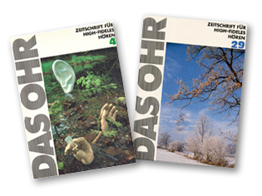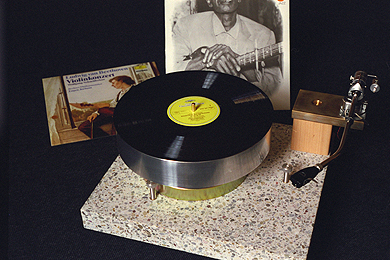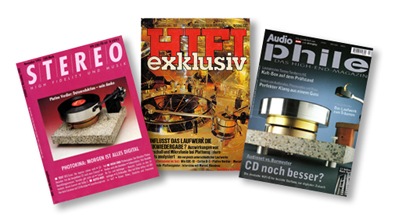| |
La
Platine Verdier
Foto:
Hifi-Exklusiv
Index
February 2018
|
|  | | | | | | Platine Verdier - since 1979 and still going strong.
The story of a resurrection
It
cannot have escaped anyone's attention that awareness of analogue music
reproduction has been constantly growing these last few years. If you have been
visiting hi-fi shows recently, in Germany and elsewhere, you will have
seen a bewildering spectrum of record players from a variety of
different brands, chrome-plated high tech concepts alongside refurbished classics from
EMT, Thorens and Garrard. We would
like to take a moment to reflect on this developement. We are not
opposed to progress or to digital music reproduction as such. Still we
ask you to spend a couple of minutes reflecting the recent past.
Digital technology has made triumphal advance, not just in audio. Our
approach to data carriers has changed fundamentally over the last
years. In the case of music, we are enjoying the new possibilities
offered by downloads, especially those provided as high resolution
files, which surpass the limitations of the CD format - not to talk
about MP3. For those of us who have undogmatically accepted this
new reality, digital or analogue reproduction are no longer mutually
exclusive. Peaceful coexistence of both technologies in one's home is
possible and meanwhile usual. The ones who have kept and extended their
vinyl collection enjoy the benefits - not least because every record is
a part of their unique biography, often bought at a young age and with
tight means, an artefact of their time, often with an astonishing
artistic quality of the record covers and giving a totally different impression of value compared to a CD or an
immaterial download file. Given this background, it is not so
surprising that the dinosaur of analogue music reproduction are
enjoying astonishing renaissance. The turntable, declared dead long
ago, is as alive as ever and indispensable for music lovers worldwide
and a steady flow of “new“ constructions enter the market.
And although the turntable has been re-invented over and over, the
black disc still rotates around a central axis. The one and only master
plan for the design of an extraordinary turntable does not seem to
exist, otherwise it could be summed up in formulas and provided on
Wikipedia for general usage. There must be something else that makes
the huge difference between the individual characteristics and
possibilities of a record player; precise manufacturing and fancy
design alone are by no means not all that is required. In
Germany and France, La Platine has achieved legendary status and has
proved to be a lasting and exceptional achievement. First presented in
France in 1979, it was an essential element in the legendary
demonstrations at La Maison de L'Audiophile. In the very early days
J.C.Verdier published the construction plans in the magazine
”L’AUDIOPHILE“, but the project turned out to be too
demanding for the DIYers, especially in getting the needed materials
One
of the early Platines which found its way to Germany were personally
delivered by Jean Constant Verdier for review to the premises of HiFi
Exklusiv in Munich where Klaus Renner conducted an interview with him,
praised the qualities of this unusual record player and purchased the
test model. The article he wrote in December 1980 was entitled
“Heavyweight from France“. | | |
Some
years later, during his time as editor and author of the German cult
publication DAS OHR (unforgotten for many of us), “La
Verdier“ accompanied his work as an indespensible tool. His
article ended up with the words “Platine Verdier, mon
amour“. Years later, another writer of this magazine compared the
turntable concept with the ingenious constructions of Leonardo da Vinci.

When
the first CD players were introduced in 1982, Jean Constant
Verdier decided to stop the production of the turntable that he had
been offering to the French market exclusively so far. The basis for
the Platine's popularity had been laid by its description in some very
early issues of the French underground magazine L'Audiophile. In the
light of the jubilant reception accorded to the first CD players and
their ease of use, turntables appeared to be redundant.
| | | Around
this time, Auditorium 23 started a mutually beneficial cooperation with
L'Audiophile and distributed their DIY-designs in Germany. For our
demonstrations of DIY-concepts like Kaneda, Classe A 20 Watt, Le
Monstre and L'Audiophile 300B, we used loudspeakers like the Petite
L'Audiophile, Triangle TQWT and Voice of the Theatre as well as record
players like the Rega Planar 3, Roksan Xerxes, Manticore Mantra or
Thorens TD 124 and 127 – due to the absence of La Verdier. At one
stage, we did a special plinth for a Roksan Xerxes to be able to
demonstrate it with an SME 3012 and Denon 103, our reference at the
time. But we never lost sight of a goal we had set for ourselves -
re-introducing the Verdier.
So we pestered our friends and
managed to drum up a total of five binding orders. We travelled to
Paris to meet Jean Constant Verdier on the premises of La Maison de
L'Audiophile and hoped to convince him. When he accepted our order
after a long discussion, having overcome his initial reservations, we
could hardly believe our luck. Neither he nor we could know that this
unique conversation would lead to a friendship and close cooperation
that has lasted for so many years now.
Some weeks later we
drove to Paris again to pick up OUR Platines. The Granito (also known
as Terrazzo) plinths that J.C. Verdier utilised at the time suffered
from an uneven mass allocation; another disadvantage
was, that
little stones particles could break out at the edges of the plinth. To
avoid discussions about which plinth design was considered to be the
most beautiful, we assigned numbers to the different Platines and
let our friends pick numbers out of a hat. One of them has kept his
numbered 1 sheet of paper to this day.
From
that day on
“La Platine“ again was available and we could
demonstrate the L'Audiophile concepts the way we had experienced them
in Paris. Inevitably, this led to additional interest in and demand for
the Platine Verdier. The little blemishes of the Granito plinth
didn't bother us, but they did bother some of our clients, so we
started looking for a solution to avoid them.
The new material
needed to have the same functional advantages as the original plinth.
Wood, which would have been the most aesthetically pleasing material,
did not fulfill that requirement. Eventually we found a
small
company specialized in the production of polymer concrete, a
material that can be combined with granulate, sand, resin and curing
agents and moulded in the required shape. The process also allowed us
to incorporate the opening for the main bearing, air chambers for
the air spring feet, bushings for adjustment screws and the tone arm
mounting. It took us quite a while to come up with the optimal size and
shape in relation to the weight and available air springs. When we
had a mould built for us, we had to keep in mind that the polymer
material will generate some reaction heat during setting and will
shrink a little while in this process. So the mould had to be a
bit larger than the final plinth and a stone mason had to grind the
plinth to exact measure (to extremely low tolerances). Quite a lengthy
and costly process. Having tested the prototype and finding out
that it lived up our hopes, we took it to Jean Constant Verdier, who
had been kept informed about the project at all times and asked for his
blessing to this alternative plinth. He agreed unreservedly with
us. From then on we could offer the Platine Verdier with our plinth.
All Platines we sold until then were equipped with this new plinth, at
their owners' request. None of them has ever asked to return to the old concept.

The photo shows that we also changed the standardly provided aluminium
armboard for a one made of bronze, resting on a block of wood.
Jean
Constant Verdier was exposed to similar market demands of course. He
refused to continue the production of the very difficult to
manufacture Granito plinth without too many regrets and
introduced MDF plinths which could be finished in fashionable high
gloss lacquer.

But
when the Platine Verdier with our polymer concrete plinth was placed on
the front page of the German magazine 'Audiophile' (1/2001), the result
was a world-wide demand for this model which now was called 'Vintage'
and which found buyers even in the Far East.

At one time,
Eliahu
Inbal, the renowned conductor, wanted to hear the first digital
recordings he did with Denon on a Voice of the Theatre speaker system.
Let‘s recall, we are in the 1980s and A23 was the only spot
in Germany able to demonstrate with high efficient history loudspeakers
and 3 watts tube amplifiers. Since we had the same
recording onVinyl, both conducted by Mr. Inbal, we were
given the
possibilty for a direct comparison by just switching from analog to
digital and reverse. After listening he asked: “Can you explain
to me the reasons why the CD conveys so much less emotional,
atmospheric and natural impact?“ He was impressed enough by
this demonstration to approach the Managing Director of Denon Germany
at the following Frankfurt High End Show, asking him not to stop the
production of our then reference cartridge the DL 103, as was rumoured
at the time. The DL 103 is still in production today. It seems that we
managed to help the many friends this cartridge still has all over the
world.
The
success story of “La Verdier“ is written by its happy
users. Since 1979 almost unchanged, the French Lady is still an object
of desire for many music lovers. Frequently copied by competitors,
always “embellished“, she can still be sure of the loyalty
of her friends and owners. The Verdier is the very basis on which their
systems are built, the antithesis to the flavour-of-the-month
mentality. It is rare to find a Platine on the second hand market, and
if one is offered, the owner will often sell at almost the price he
bought it for or even more. Almost unchanged in technical details from
the beginning this record player sovereignly still competes with
present days competitors.
The appreciation of extraordinary
products is also reflected in verbal references. The phrase “as
good as ...“ or “better than ...“of competitors when
promoting the excellence of their own products implies that there are
references. Here, “La Platine Verdier“ as well as “La
Nouvelle“ from A23 (which received the “DIAPASON
d'Or“ Award by the French magazine “DIAPASON“ in
2002) obviously managed it to remain a benchmark for quality and
musical performance to this day. In an environment of rapidly changing
markets La Platine remained the solid rock in the audio systems of the
majority of their owners. The story continues, now in the USA - almost
40 years after the first performance in France.
Looking back to 1979 we read headlines like these:
Ayatollah Khomeini takes over the power in Iran.
Idi Amin goes into exile.
Coppola's »Apocalypse Now« runs in theaters.
Rudi Dutschke dies in the age of 39 years.
Mother Teresa receives the Nobel Peace Prize.
Volker Schlöndorff filmed »The Tin Drum«.
First publication about Platine Verdier in France.
Some of today's fans were still kids.
As
for us, we can’t deny a certain pride and contentment that A23
was able not only to have convinced Jean Constant in the 1980s to
manufacture this great and timeless turntable anew, but also about the
fact that we helped to turn this record player into a legend. And
we are happy about the fact that the friendly relationship to the
family
Verdier further persists with his wife Michelle and his son Eric after
the all too early death of Jean Constant in 2014.
Here you find PDF-files of the mentioned articles
| | | Hifi Exklusiv | DAS OHR Nr. 4 DAS OHR Nr. 29 | | |
STEREO |
Audiophile | | | | | |
|
|